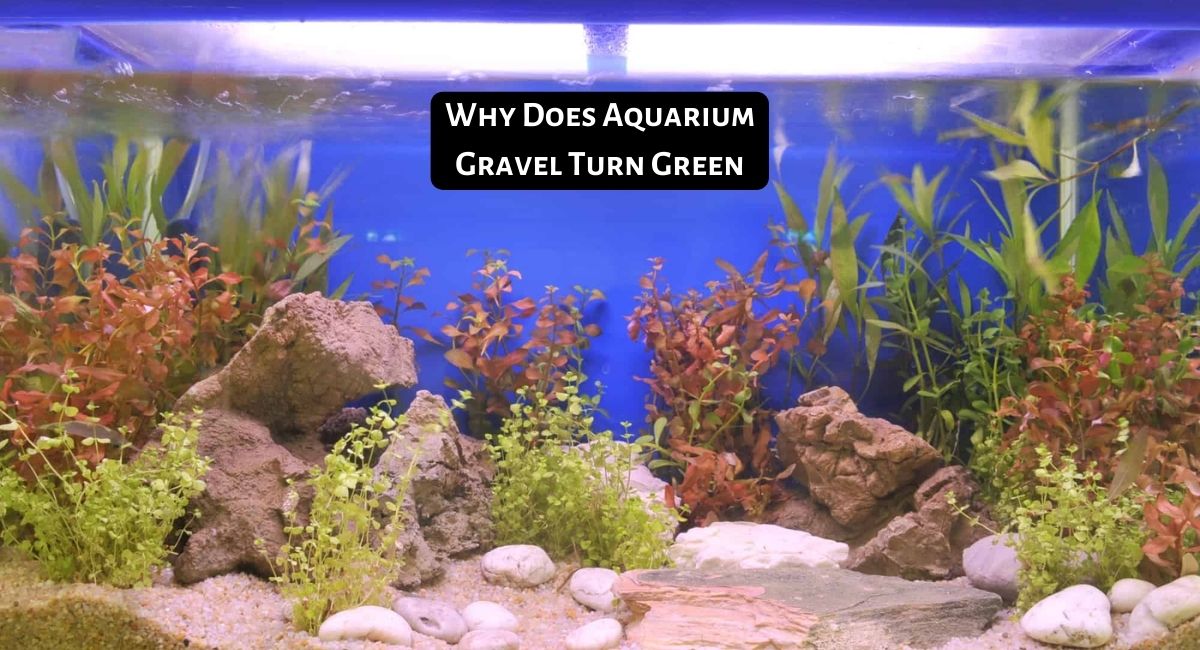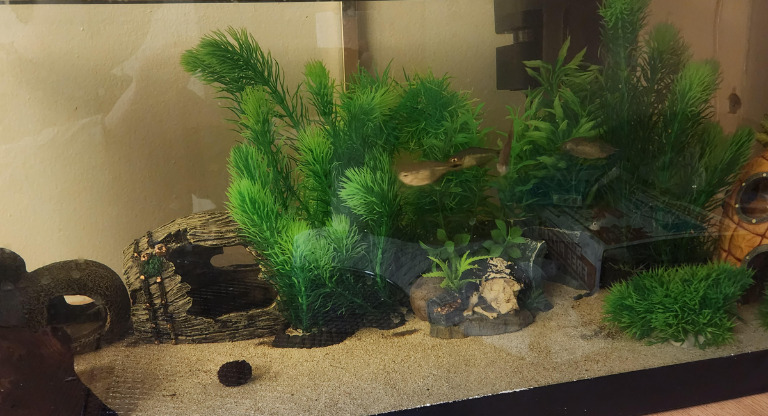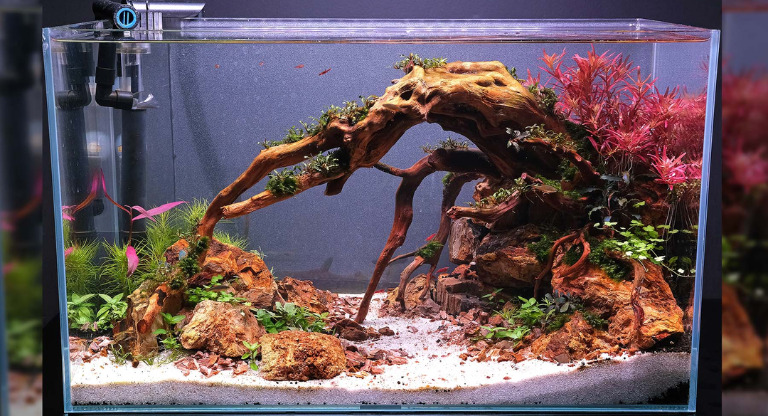Smartplantedaquarium.com participates in affiliate marketing programs. We may earn commissions on purchases made through our affiliate links. This doesn't affect our content or recommendations and we only recommend products we would put in our own tanks.
Have you ever noticed the sand and gravel in your aquarium taking on a mysterious green hue? It’s a common occurrence that can leave many aquarium enthusiasts puzzled. In this article, we’ll delve into the fascinating world of aquarium maintenance to uncover why your aquarium substrate might be turning green.
Understanding the reasons behind this can help you maintain a healthy and vibrant aquatic environment for your finned friends. So, let’s dive in and demystify this green transformation.
Contents
Key Takeaways
- Aquarium sand and gravel can turn green due to the growth of green algae.
- Factors that contribute to green algae growth include excessive light, nutrient imbalances, poor water quality, lack of competing plants, stagnant water, high pH levels, and inadequate cleanup crew.
- To prevent and remove green algae from aquarium substrate, you can vacuum the substrate, scrub the decor, reduce light duration, minimize sunlight, conduct a partial water change, consider chemical treatment as a last resort, introduce algae-eating fish and invertebrates, reduce overfeeding, use quality filtration, introduce live plants, monitor and adjust pH levels, and maintain proper water circulation.
- The timeframe for aquarium gravel to turn green with algae can vary, depending on various factors.
Why Does Aquarium Sand and Gravel Turn Green
Aquarium sand and gravel can turn green due to the growth of green algae. Green algae blooms are usually caused by factors such as excessive lighting, poor water quality, and increased levels of nitrates and phosphates in the tank water. When these conditions are present, the algae multiply rapidly and can cover the sand and gravel, giving it a green appearance.
To prevent or control green algae growth in aquarium sand and gravel, it is important to take proper preventive and maintenance measures. Taking steps to manage lighting, optimize water quality, and implement regular cleaning practices will help create a healthy and visually appealing aquarium for both the fish and the hobbyist. By maintaining a balanced ecosystem, you can enjoy the beauty of your aquarium sand and gravel without the intrusion of green algae.
Types of Green Algae in Aquarium
Green algae in aquariums can manifest in several forms, each with its own characteristics. Understanding these different varieties can help aquarists identify and manage potential algae problems, promoting a healthy and visually appealing aquatic environment for their fish, plants, and other inhabitants.
By gaining insights into the characteristics, causes, and control measures associated with these algae types, aquarium enthusiasts can cultivate an optimal balance within their tanks and enjoy the beauty of their underwater world.
- Green Water (Algae Bloom): This condition occurs when there’s a rapid growth of microscopic algae suspended in the water, causing it to turn green. It’s often triggered by excessive light and high nutrient levels, particularly nitrates and phosphates. Overfeeding and overstocking the aquarium can exacerbate this condition. While not directly harmful, green water can obstruct visibility, making it hard to observe your fish and monitor their health. It can also impact the growth of aquatic plants by limiting the light available for photosynthesis.
- Green Spot Algae (GSA): Green spot algae form hard, circular green spots that are tough to remove. They typically grow on aquarium glass, slow-growing plants, and decorations. This type of algae is usually a sign of low CO2 and phosphate levels. While it doesn’t harm fish, it can inhibit plant growth by covering their leaves and blocking light.
- Green Dust Algae (GDA): Green dust algae appear as a layer of green “dust” on aquarium surfaces, including the glass and decorations. It can be easily wiped off, but it tends to return quickly if the underlying issue, usually excessive light and nutrients, is not addressed. This type of algae is more of an aesthetic issue and doesn’t typically harm fish or plants.
- Green Hair or Thread Algae: This type of algae grows in long, hair-like strands and can attach to any surface within the aquarium. It’s often a sign of high nutrient levels, particularly nitrates and phosphates. Hair algae can become problematic if it grows too thick, as it can entangle fish and cover plants, blocking light and inhibiting growth.
- Green Beard Algae: Green beard algae grow in tufts that resemble a beard. They can be tough to remove and are often a sign of inconsistent water conditions. Like hair algae, beard algae can entangle fish and block light from reaching plants if it grows too thick.
- Green Fuzz Algae: This type of algae grows in short, fuzzy strands on aquarium surfaces. While it’s not harmful, it can be unsightly if it covers large areas. It can also compete with aquatic plants for nutrients and light.
- Green Slime or Blue-Green Algae (Cyanobacteria): Despite its name, blue-green algae is actually a type of bacteria. It forms a slimy layer that can be green, blue-green, or even red. Cyanobacteria can produce toxins that are harmful to fish and plants. It thrives in conditions with high organic waste and low oxygen levels.
Causes of Green Algae Growth on Aquarium Substrates
Green algae, also known as chlorophyta, are a common and natural occurrence in aquatic environments. However, excessive green algae growth in an aquarium can signal an imbalance in the ecosystem. Let’s explore the factors that contribute to green algae growth on aquarium substrates:
Excessive Light
Algae, like all photosynthetic organisms, require light for photosynthesis, a process by which they convert light energy into food. When aquariums are exposed to too much light, especially direct sunlight or prolonged artificial lighting, it creates an ideal environment for algae to thrive. To address this issue, it’s important to regulate the duration and intensity of light in the aquarium. Using a timer to mimic natural day-night cycles can help control excessive light exposure.
Nutrient Imbalance
Algae need essential nutrients to grow, including nitrates and phosphates. Overfeeding your fish can lead to leftover food settling on the substrate, contributing to increased nutrient levels in the water. Additionally, fish waste and decaying plant matter release nitrates and phosphates into the water. Regular feeding and proper portion control can help prevent excess nutrients from accumulating. Installing a quality aquarium filter and conducting routine water changes can also assist in maintaining proper nutrient levels.
Poor Water Quality
Neglecting water quality can lead to algae problems. If water changes are infrequent or the filtration system is inadequate, organic matter like uneaten food, fish waste, and decaying plants can accumulate in the tank. This organic debris serves as a nutrient source for algae. To combat this, perform regular water changes (usually 10-20% of the water every 1-2 weeks) and invest in an efficient filtration system to remove excess nutrients.
Lack of Competing Plants
Aquatic plants and algae compete for nutrients in the water. Having a variety of live plants in the aquarium can help absorb excess nutrients, making it harder for algae to thrive. Ensure your aquatic plants receive proper care and nutrition to outcompete algae. Pruning and maintaining healthy plant growth can also prevent nutrient imbalances.
Stagnant Water
Areas of stagnant or low water circulation can create pockets where nutrients accumulate, promoting algae growth. Installing a suitable aquarium water pump or filter to maintain water movement and circulation can prevent the formation of these stagnant areas. Adequate circulation ensures even distribution of nutrients, making it difficult for algae to establish themselves.
High pH Levels
Green algae tend to thrive in alkaline (high pH) conditions. If your aquarium water has a consistently high pH, it can encourage green algae growth. Regularly monitor and adjust the pH levels as needed to keep them within the preferred range for your fish and plants. This may involve using pH buffers or selecting species of fish and plants that thrive in your water’s natural pH.
Inadequate Cleanup Crew
Certain aquarium inhabitants, such as algae-eating snails, shrimps, and fish like plecos or Siamese algae eaters, can help control algae growth by consuming it. Not having an appropriate “cleanup crew” can result in unchecked algae growth. Research and introduce suitable algae-eating species to help maintain a balance in your aquarium.
How to Prevent and Remove Green Algae from Aquarium Substrate
Green algae, while natural, can sometimes overpopulate an aquarium, detracting from its aesthetic appeal and indicating an imbalance in the tank’s ecosystem. Here’s a step-by-step guide on how to remove green algae from aquarium substrate:
Vacuum the Substrate
Begin by using an aquarium gravel vacuum, a specialized tool designed for cleaning aquarium substrates. Run the vacuum over the substrate to remove loose algae and any debris that may have settled. This action not only eliminates algae but also helps remove some of the excess nutrients that algae need to grow. It’s crucial to perform this step gently to avoid disturbing the substrate too much.
Scrub the Decor
Next, remove any aquarium decorations, plants, and rocks from the tank. Place them in a bucket filled with aquarium water to prevent them from drying out and losing beneficial bacteria. Use a soft brush, like a toothbrush or a dedicated aquarium scrubber, to gently scrub off algae growth from these items. Do not use any soaps or detergents, as residue can harm your aquatic inhabitants.
Reduce Light Duration
Excessive lighting is often a primary contributor to green algae growth. To address this, consider reducing the amount of time your aquarium lights are on. Limiting the light cycle to around 8-10 hours per day can be effective in controlling algae. Using a timer can help automate this process.
Minimize Sunlight
If your aquarium is located near a window where it receives direct sunlight, consider moving it to a shadier spot or using curtains or blinds to block out the sunlight. This prevents the introduction of additional light that can fuel algae growth.
Partial Water Change
Conduct a partial water change by removing and replacing approximately 20-30% of the aquarium water. This step helps dilute the nutrient levels in the tank that may be supporting algae growth. Always use dechlorinated water for water changes or let tap water sit for 24 hours before adding it to the tank to allow chlorine to dissipate.
Chemical Treatment
Some aquarium-specific algaecides are available for use in controlling algae. It’s essential to follow the manufacturer’s instructions carefully when using these products. Overuse or misuse of algaecides can harm your fish and other aquarium inhabitants. Consider chemical treatments as a last resort when other methods have proven ineffective.
Biological Control
Introduce algae-eating fish and invertebrates into your aquarium. Species like otocinclus catfish, siamese algae eaters, amano shrimp, or nerite snails are known for their appetite for algae. However, ensure that any new additions are compatible with your existing tank inhabitants to prevent conflicts or stress.
Reduce Overfeeding
Overfeeding is a common cause of excess nutrients in the water, which can lead to algae growth. Feed your fish only what they can consume within a few minutes. Remove any uneaten food promptly to prevent it from decaying and adding nutrients to the water.
Quality Filtration
Consider using a high-quality aquarium filter. Effective filtration helps remove excess nutrients and particles from the water, maintaining better water quality and preventing algae growth. Regularly clean and maintain your filter to ensure its optimal performance.
Live Plants
Introducing or increasing the number of live aquatic plants in your aquarium can be beneficial. Live plants compete with algae for nutrients, reducing the availability of nutrients for algae growth. Make sure to choose plants that are suitable for your aquarium setup and lighting conditions.
Monitor and Adjust pH Levels
Regularly monitor and maintain a stable pH level appropriate for your aquarium’s inhabitants. pH test kits are available to help you keep track of pH levels. Many fish and plants have specific pH requirements, so adjust the water chemistry accordingly.
Maintain Proper Water Circulation
Ensure your aquarium has adequate water circulation to prevent stagnant areas where algae can proliferate. Using water pumps or powerheads can assist in achieving good water flow and distribution of nutrients.
Discover the most common challenges that aquarium enthusiasts face with their substrate, from gas buildup to discoloration. Learn effective solutions and proactive measures to maintain a healthy and visually appealing aquatic environment for your fish and plants. Dive into the world of aquarium substrate management and keep your underwater paradise thriving.
How to Reduce Anaerobic Gas Build Up in Fish Tank Substrate: Discover effective strategies to prevent anaerobic gas buildup in your aquarium substrate, ensuring a healthier and safer environment for your aquatic pets.
Why Does Fish Tank Sand Float: Dive into the science behind the perplexing phenomenon of floating aquarium sand and learn how to address this issue to maintain a balanced aquatic ecosystem.
Why Does Fish Tank Sand and Gravel Turn Yellow: Uncover the causes of yellowing aquarium gravel and learn valuable tips to maintain the aesthetic appeal of your aquarium setup.
Why Does Fish Tank Sand and Gravel Turn Black: Delve into the dark side of aquarium sand as we explain the factors leading to black discoloration and share methods for keeping your substrate pristine.
Why Does Fish Tank Sand and Gravel Turn Brown: Learn about the natural processes that can turn your aquarium sand brown and how to prevent or rectify this issue to maintain a clean and attractive aquatic habitat.
How to Prevent Aquarium Substrate Compaction: Discover essential tips and techniques for preventing the troublesome issue of substrate compaction in your aquarium, ensuring a healthy environment for your aquatic inhabitants.
Conclusion
We’ve explored the reasons behind why aquarium sand and gravel turn green. We’ve learned that factors like algae growth, light exposure, and nutrient levels play a crucial role in this phenomenon.
By understanding these factors, aquarium enthusiasts can take steps to maintain a clean and healthy aquatic environment for their beloved fish and plants. Remember, proper maintenance and regular cleaning can help keep your aquarium sand and gravel looking vibrant and free from unwanted green hues.
Frequently Asked Questions
1. How long does it take for aquarium gravel to turn green?
The timeframe for aquarium gravel to turn green with algae can vary. It depends on factors such as lighting intensity, nutrient levels, and the presence of algae spores in the aquarium. In some cases, algae growth can become visible within a few weeks, while in others, it may take longer. Establishing a proper balance in the aquarium ecosystem and implementing preventive measures can help delay or minimize the occurrence of green algae on the gravel.
2. Is green algae harmful to fish?
In general, green algae itself is not harmful to fish. However, excessive green algae growth can cause several issues. It can reduce water clarity, limit visibility, and deplete oxygen levels in the aquarium. Dense algae growth may also compete with aquatic plants for nutrients and light, potentially hindering their growth. Additionally, decaying algae can release organic compounds that may affect water chemistry. While green algae is not directly harmful to fish, it’s essential to manage its growth to maintain a healthy aquarium environment.
3. Can I use chemicals to eliminate green algae in my aquarium?
Using chemicals to eliminate green algae in an aquarium is not recommended as the primary method of control. Algaecides or chemical treatments can disrupt the delicate balance of the aquarium ecosystem and harm beneficial organisms. It’s best to address algae issues through preventive measures such as proper lighting, nutrient management, regular maintenance, and the introduction of algae-eating organisms. These natural methods are safer and more sustainable in the long run.
4. How to get rid of green algae on aquarium glass?
To remove green algae from aquarium glass, start by using an aquarium-safe algae scraper or sponge. Gently scrape the algae off the glass, making sure not to scratch it. Rinse the scraper or sponge as needed and continue scraping until the glass is clear. Wipe away any remaining residue with a cloth or paper towel. Dispose of the collected debris responsibly. Monitor the water parameters and make any necessary adjustments. To prevent future algae growth, manage lighting and nutrient levels, and perform regular maintenance practices. This will help keep your aquarium glass free from green algae and maintain a clear view of your aquatic environment.
5. How to get rid of algae in fish tank naturally?
To get rid of algae in a fish tank naturally, maintain proper water parameters by testing and adjusting ammonia, nitrite, nitrate, and phosphate levels. Control lighting by adjusting duration and intensity to minimize excessive light. Introduce and maintain live aquatic plants to compete with algae for nutrients. Add algae-eating organisms like Siamese algae eaters or Amano shrimp. Manual removal of algae with a scraper or sponge is effective. Practice proper tank maintenance, avoid overfeeding, and maintain a balanced ecosystem. These natural methods will help control and reduce algae growth in your fish tank.






